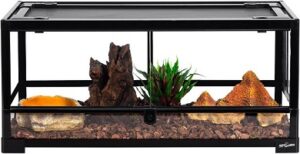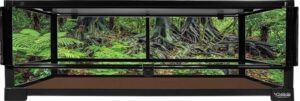To properly care for a leopard gecko, you’ll need various supplies to create a suitable habitat and meet their specific needs. Here’s a comprehensive list of essential supplies for leopard gecko care:
1. Terrarium:
– Enclosure: A glass terrarium or tank with secure, ventilated lids. For a single adult leopard gecko, a 20-gallon long tank (30” x 12” x 12” or 76 x 31 x 31 cm) is recommended. Larger tanks are preferable for multiple geckos or to provide additional space for enrichment.
– Substrate: Choose a safe and appropriate substrate, such as reptile carpet, slate tile, paper towels, non-adhesive shelf liner, or bioactive substrates designed for arid environments. Avoid loose substrates like sand, as they can pose a risk of impaction.
2. Heating and Lighting:
– Heat Source: Under-tank heating pads, heat mats, or ceramic heat emitters to provide a warm basking area. Ensure proper temperature gradients within the enclosure.
– Thermometers: Digital or analog thermometers to monitor temperature levels in the warm and cool areas of the terrarium.
– Lighting: While leopard geckos do not require UVB lighting, provide a low-wattage incandescent bulb or LED light to establish a natural day-night cycle.
3. Hides and Décor:
– Hiding Places: Provide multiple hiding spots, including warm and cool hides, to allow your gecko to feel secure and regulate its body temperature.
– Decorative Items: Rocks, branches, cork bark, artificial plants, and other reptile-safe décor items to create a stimulating and naturalistic environment.
4. Water and Humidity:
– Water Dish: A shallow and stable water dish filled with fresh, dechlorinated water at all times for drinking and soaking.
– Humid Hide: A moist hide filled with damp substrate (e.g., sphagnum moss) to aid in shedding and maintain proper humidity levels.
5. Feeding and Supplements:
– Feeder Insects: Live insects such as crickets, dubia roaches, mealworms, superworms, and waxworms to provide a varied diet.
– Calcium Supplement: Calcium powder without vitamin D3 for dusting feeder insects to prevent metabolic bone disease (MBD).
– Vitamin Supplement: Multivitamin powder containing vitamin D3 for occasional supplementation to support overall health.
6. Cleaning and Maintenance:
– Substrate Cleaner: Reptile-safe substrate cleaners or disinfectants for spot cleaning and periodic enclosure maintenance.
– Cleaning Supplies: Paper towels, sponges, brushes, and other cleaning tools for maintaining cleanliness in the terrarium.
– Waste Disposal: Sealable bags or containers for disposing of waste and soiled substrate.
7. Handling and Care:
– Handling Tools: Gentle handling tools such as a soft brush or scoop for safely interacting with your gecko.
– First Aid Kit: Basic first aid supplies, including wound care products, antiseptic solutions, and tweezers for handling.
8. Educational Resources:
– Books, online resources, and reputable websites for learning about leopard gecko care, behavior, and health.
By providing these essential supplies and meeting the specific requirements of leopard geckos, you can create a comfortable and enriching environment for your pet to thrive. Regular monitoring, proper husbandry practices, and veterinary care are essential for ensuring the health and well-being of your leopard gecko.



